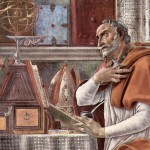
In loving memory of Fr. Sam Homsey C.PP.S. (1910 – 2004)
As a teenager, I played basketball on a small cement slab behind the parish rectory where we lived. My Dad was the pastoral coordinator at St. Patrick’s Catholic Church (in Brady, Texas) at the time. I was told that the place I played at was once the entryway for a small chapel dedicated to Our Lady of Guadalupe. In that small chapel, there would be Spanish-language Masses offered for the Mexican faithful who attended Mass in Spanish.
I didn’t think too much of it until I met Fr. Sam. Fr. Sam was a Lebanese (he preferred to call himself an Arab) priest of the Society of the Precious Blood who never retired until the day he died sitting in the passenger seat during a car accident. He was well into his nineties and showed no signs of slowing down.
He taught me that the cement slab I played on was a very common thing to be found in the Diocese of San Angelo when he came to serve as pastor of Mary, Star of the Sea (a somewhat strange name for such a landlocked town) in Ballinger, Texas in 1980. He was well into his life and priesthood by that time and had just finished missionary work in Chile. Long before that, he taught high school and served as the pastor of two Black Catholic congregations in Nashville, Tennessee for six years during the late 30’s and early 40’s. He was never bitter about racial tension; but he was not naive or inexperienced either.
As a seminarian, he was proud to be the only Arab, even when it disadvantaged him. He sang tenor in the choir and was the center for his college football team, weighing-in at 165 pounds. He spoke or read English, Arabic, Hebrew, Latin, Spanish, French, and German. His Spanish oratory far exceeded the skills of many second and third generation Hispanic priests. He rarely spent any money and gave it away primarily to fund the education of bright young men to become priests— he offered me a scholarship, but I wasn’t sure whether I could follow through with the vocation.
When he arrived in Ballinger in 1980 and encountered the “Mexican church,” La Capilla de Nuestra Señora de Guadalupe, he didn’t make a fuss or write letters to the newspaper or the Bishop. He simply informed the Mexican faithful gathered for Mass that next week Mass would be celebrated at the parish sanctuary with the entire Catholic community. And he did the same for the English-speaking faithful too. I am not sure how the logistics went for the transition, but he did tell me, somewhat gleefully, that he got into a good bit of trouble with the Bishop for not informing him before making these major changes.
Apparently there was a good deal of outrage on the part of the predominantly German-American Catholics (and other European descendants too, I imagine) for including Spanish Masses and their Mexican faithful into the life of the main, “White church.” But that was not all. There was also a good deal of Mexican discomfort with the eradication of their “Mexican church.” The protests were not equal to one another; clearly the most outrage was from the “White church”—especially those who were influential in the local community.
Nonetheless, in 1980 Fr. Sam Homsey began a movement that has now become the norm: the racial integration of West Texas Catholic parishes.
Racial tension has not gone away altogether. Most West Texas parishes have an early-morning or Saturday-evening Spanish Mass and later-morning English one. There are also plenty of bilingual services, especially at Christmas and Easter. In many of those liturgies you can smell scents of days-not-gone-by.
For example, during the Our Father, depending on what language it is said in, you will hear a few stubborn people who say it “their way,” in the other language, so as not to let the “other side” win. Planning a bilingual liturgy can be a careful balancing act; deciding what will be said, sung, or read in English or Spanish can be something like a political negotiation; no one wants to make the “other side” feel slighted, everyone wants to be well represented.
In the life of the typical West Texas parish there are also many places and people where the organic fusion of culture is evident (many of my dearest friends from Brady have never shown me anything but great love and brought me much joy), but there are still those places where strict, racial lines are the unspoken law—including the Mexican side: you hardly find a Guadalupana (a member of a traditionally Mexican woman’s society) who is of European descent.
What does this have to do with Our Lady of Guadalupe? Well, it is a modern version of what the story means for so many Mexicans who adore her and Juan Diego. The title Virgen Morena (dark-skinned Virgin) is deeply counter-cultural in a culture like our own where, to this very day, the lighter-skinned person—who may be a Hispanic criollo or a German-American, or even a light-skinned Negro—is the preferential option for power; anyone other than that model is a notable exception.
In the classic Mexican song of the holy day, La Guadalupana, there is a verse that sounds nationalistic—and there is a disturbing Mexican nationalism to this holiday—but is actually very different. The verse goes:
Suplicante juntaba sus manos, Suplicante juntaba sus manos. ¡Y eran Mexicanos! ¡Y eran Mexicanos! Y eran Mexicanos su cuerpo y su faz.
Translation: Supplicating she held her hands, Supplicating she held her hands. And they were Mexican! And they were Mexican! And her body and face were Mexican.
It literally repeats “And they were Mexican!” which is to say, “Mary was Mexican-looking!” The song sounds surprising even today. Mary came and visited this indigenous peasant, Juan Diego— news in itself—and was Mexican-looking! What a surprise! Who would have thought? Mexican- looking people getting celestial, preferential treatment!
These are the politics of Guadalupe: It is a holy day for Mexican-looking people. And there are so many Mexican-looking people who are not Mexican (and, of course, so many of them who are). Anyone who is oppressed by the look of their hands, face and body, can look with devotion to that dark-skinned Virgin and find hope. And this hope is not simply for the soul, it is for the body and the mind and the politics of the day.
For the rest: To be Catholic and still look down on an immigrant, a migrant worker, or pay any person unfair wages and alike is to be blind to the political challenge of Our Lady of Guadalupe. This may be why I have been told by non-Mexican-looking friends that this day makes them feel uncomfortable. The politics of Guadalupe is also why Fr. Sam seemed to have such a profound ability to see the plight of others and simply act: because he too was Mexican-looking— an Arab from Missouri.
We cannot all be Mexican-looking, but we can all become Mexican at heart. Some of the most Mexican-at-heart people I know have been of European, Asian, and African descent. There are too many Mexicans who merely look Mexican, but have forgotten the politics of Guadalupe in their own treatment of others, and even, perhaps, themselves.
The politics of Guadalupe are still needed today. Not only in the world at large: in our parishes and our homes too. Far too many Catholics harbor racial preference for who they see as “their own kind” in the privacy of their home, yet pretend to be together at Sunday Mass. Far too many Catholics will give their hand during the sign of peace to a dark-skinned hand but would never offer their daughter’s hand to that same person in marriage. It is an odd feeling to be at Mass as “equals in the Lord” knowing that the Eucharistic minister or lector will not allow you to date or marry their daughter because you are Mexican-looking. Far too many Catholics divide their faith into a perverse form of racial and national pride. Mexicans should never attach that despicable saying “La Raza” (“The Race”) to Our Lady. And the list goes on and on for so many of us.
On this day of Our Lady of Guadalupe, rather than become superstitiously enamored with ourselves and own kind, we should try to find the most overlooked and ignored people we live among and appear to them as Mary did to Juan Diego—and as Gabriel did to Mary and as Jesus does to Mankind. The Dark-skinned Virgin should be a deep symbol for all Catholics that shows the preference for the poor, the weak, the oppressed and the suffering in the heart of Our Mother and her Son. But we cannot merely “appear”: we must appear in a flesh not unlike their own.
In an appropriate way for this season of Advent, the politics of Guadalupe are a preparation for the politics of the Incarnation.
(This essay is taken from my book of essays, Things and Stuff.)











